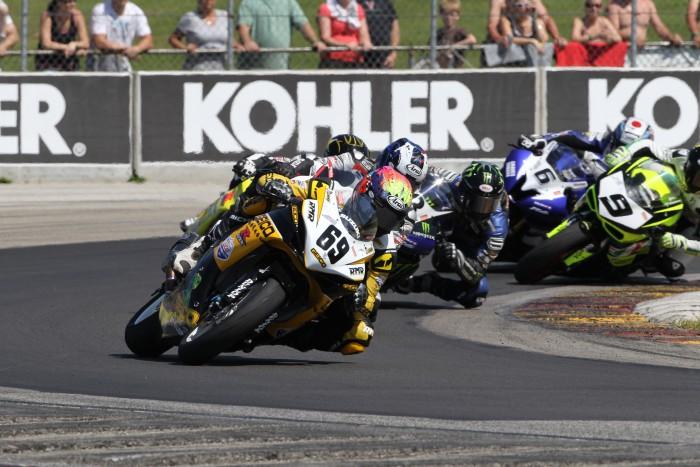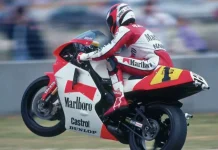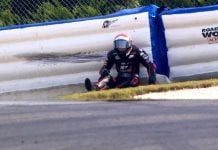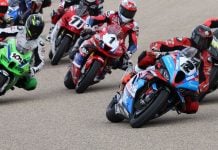First Person/Opinion: A Recovery Program For Former AMA Pro Racing Fans And Assorted Other Haters By Michael Gougis If you’ve missed the racing in the AMA Pro Racing series this season, you’ve missed some spectacular events. To pick just one: Dane Westby slicing his way from deep in the field to win the first Daytona SportBike race at Mid-Ohio was something you won’t see this year in MotoGP or World Superbike. Watching Blake Young, Josh Hayes, Tommy Hayden and the rest of the crew battling at the very front of the pack for first in Superbike has been heart-stopping, lap after lap, race after race. And still, the whining continues. “It’s not as good as it used to be. I’m not gonna watch,” the critics bleat, oblivious to the dramatic on-track action and the simple rather stunning fact (when you think about it) that in a country where most of the population routinely refers to motorcycles as “organ donor machines,” there is a major professional motorcycle road racing series at all. There are always going to be some people who will never be happy give them a bag of gold, they’ll complain about how much it weighs. But there are, I suspect, a fair number of people who are parroting old and outdated complaints, race fans who want to be fans of AMA Pro road racing again, but have developed an addiction to complaining and pining for the ‘Good Old Days’ and who can find other addicts to echo their negativity on the Internet, reinforcing their discontent. This is for you. There is a way back. Three steps is all it takes. One: The Old Days Are Gone, And Sniveling Isn’t Going To Bring Them Back No sane person would argue that the AMA Pro’s former regime did a consistently good job in running the series. The mistakes ranged from the ghastly ask Thomas Wilson or Grant Lopez about some of the tracks the series raced at to the comical. Melting down engine cases and re-casting them with new bore centers is legal under a rule that says “unlimited modifications” are allowed to the crankcases of production-based Twins in Formula Xtreme, as the old regime ruled in the case of the XBRR circa 2006? Really? Recasting different crankcases is the same as cutting and welding production crankcases? You believe that, I’ve got a bridge for sale “¦ The good news is that all the people involved in the craziest of AMA Pro insanity are now long gone, including the man who homologated the XBRR and the entire tech crew involved in the 2008 disqualification of Mat Mladin and not Ben Spies–over a crankshaft both ran. Ditto Roger Edmondson, the man who believed ignoring the rulebook, homologating a rulebook-illegal motorcycle and allowing the timing and scoring crew to vindictively, selectively hand out multiple ride-through penalties each weekend for grid “infractions” visible only when video was viewed frame-by-frame and judged on the basis of “pixel movement.” Ditto that corrupt timing and scoring crew, which bragged about targeting specific riders based on who they rode for and what they said in news reports. Ditto the race director who said such enforcement was justified because “we’re trying to eliminate judgement calls,” and who then handed out Superbike licenses to riders who didn’t meet the minimum requirements, justifying it by saying “I made a judgement call.” The guys in charge now actually know something, and have demonstrated a common-sense approach to officiating. Paddock denizens who lived through decades of the bad old days say that race operations and officiating have never been better and have never been fairer than they are right now. The other part of the good news is that after losing $1.9 million on professional racing operations in the 12-year existence of its controversial for-profit Paradama subsidiary, the non-profit American Motorcyclist Association (AMA) based in Pickerington, Ohio sold off its Pro Racing assets and the right to do business as AMA Pro Racing to Daytona Motorcycle Group (DMG) for about $12 million. In 2009 alone, DMG payments to AMA Ohio totaled $1.9 million. Which means that in one year alone, AMA Ohio made back all the membership money it had squandered while mismanaging professional racing operations for more than a decade. The timing could not have been better: The revenue stream started just as the recession peaked, ensuring the survival of one of the most effective advocacy groups working to protect motorcycling from government lunacy on all levels. Looking at history, factory participation in professional racing is linked to motorcycle sales. For example, in 1983, Kawasaki won the AMA Superbike Championship with Wayne Rainey. At the end of the year, the company announced that it was not selling enough bikes and quit racing. Rainey spent 1984 riding a nearly stock Yamaha TZ250 in World Championship events and struggled mightily getting to terms with the dead-engine, push-starts then used. Meanwhile, AMA Pro grids mostly consisted of privateers working out of pickup trucks and vans. As for the impact of the current recession, the reality is that the global economic downturn did far more than anybody associated with AMA Pro Racing did to kill off trick nearly-prototype racing machines, high-dollar factory efforts and bucks-up rider salaries. Factories go racing to sell machines. When a company like Suzuki doesn’t even import GSX-Rs to the United States for an entire year (2010), it makes little sense to expect Suzuki to sink tons of money into exotic materials, expensive testing, or anything else. With national unemployment at 14%, fans who can’t afford to travel don’t go to races, they watch them on TV (more on that in a moment). Racing is part of the motorcycle business; when business suffers, racing suffers. Really, to me, the question isn’t whether Mat Mladin wanted to keep racing or not; the question is, with motorcycle sales at a virtual standstill, with GSX-Rs piling up in warehouses, how much of a pay cut was Suzuki going to demand that he take for the next season? The answer is, too much for him to accept. When his offer to take himself and his crew to another manufacturer for $5 million a year drew exactly zero takers, he went home to Australia. Few seem to remember that DMG, in response to the Japanese manufacturers’ fleeting demand for a class that more closely resembled World Superbike rules, agreed to use those rules and allow factories to run their WSB bikes, on whatever tires they wanted, with no restrictions on testing. That was going to be the Factory Superbike class for 2009. Not one motorcycle manufacturer said yes, and the manufacturer that had called the loudest for those rules then denied having done so (although that same company has now renewed its call for World Superbike rules). Maybe after the first time factory accountants looked at the proposal, had cardiac arrests and were carted off in body bags, cooler heads decided that maybe having a National four-stroke virtual prototype arms race in the middle of a recession was a bad idea. The funny thing is critics now surfacing and saying we need works racebikes that allow development that can be used to benefit production. Funny, Supercross used to have that but went to motorcycles based more closely on production bikes, and nobody made the same argument. The bikes raced in Supercross are the knobby-tired equivalent of what we now have in AMA Pro road racing. Simply put, no one in Supercross or AMA Pro Superbike could keep things going the way they were it was simply too expensive for the times. The current rules package for American Superbike wasn’t rammed down the manufacturers’ throats it’s the package the ones who wanted to race, thought they could survive under. Look at other National series, in Canada, Great Britain, Australia. Spec tires. Multiple classes running at the same time. It’s all a response to the fact that the old ways of running a National Superbike class are gone. One other critical change has taken place in the last three years torrent sharing. Quasi-legal at best, the practice is insanely widespread, and what it means is that anyone with an Internet connection can watch more racing than they have time for on any given day. AMA Pro Racing isn’t just competing with the local events for a potential fan’s attention; it’s now competing with MotoGP and World Superbike and British Superbike and the Italian and German National series and the World Endurance series and each and every one of those series’ support classes. All of these races can now be watched in the comfort of one’s home on an expansive high-definition flat-screen with rich surround sound, at a time and date chosen by the viewer. Trying to convince a fan to leave the creature comforts of home and come to the track becomes harder and harder with each technological advance (there’s a reason a large segment of the U.S. population is obese). Ignoring the effect this has had on at-track attendance is like pretending the Earth is flat. The economy and technological advances with the massive shooting-themselves-in-the-foot moves of AMA and DMG officials, especially in 2009 have killed off the old days. Whining about “How Good It Was” doesn’t help bring them back. People who still do this remind me of the people who still think something like the virtually unlimited Can-Am sports car series of the 1960s would be a good idea as if there’s a track where you could safely race a 2000-horsepower car with active aerodynamics or more than two people who would want to develop it. Or they complain that no one has a class for truly unlimited racing motorcycles anymore. There’s a reason no motorcycle company wants to–or can afford to–race in that class. Those days are as gone as the roadster’s day at Indy. Acceptance is the first key to recovery. Two: Seize The Moment You can do this in the privacy of your own home, when none of your AMA/DMG-hate support group is watching. Find a copy of a recent AMA Superbike race, for example either race at Barber Motorsports Park or either race at Mid-Ohio. Watch it. What’s that going on at the front of the field? It’s called passing! On any given weekend, the AMA Pro Superbike series will field as competitive a group of racers and riders as anywhere in the world. It’s not just Yoshimura Suzuki and factory Yamaha anymore; the satellite teams are fighting for the win and winning! The margins are close, the passes are closer. The on-track action is the equal to anything going on anywhere in the world. But the bikes are so stock, they’re not like the prototypes that they used to race, the whine continues. First off, they’re really not as stock as some people claim. Second, take a look at the stuff that comes on a stock motorcycle. Ask Eddie Lawson or Kevin Schwantz if they would have liked adjustable fuel/ignition maps, traction and wheelie control, and frames and forks that look like they were pilfered from the back of a World Superbike rig. There’s more trick stuff on some stock motorcycles than there was on the trickest of Superbikes a decade or more ago. And a built AMA Superbike it’s a beast that cranks out at least 20 to 30 horsepower more than the much-missed 500cc GP bikes of ages past. Earlier this month, Tommy Hayden hit 177 mph at Mid-Ohio not exactly a high-speed track. Some of you may remember Lawson winning the 1993 Daytona 200 on a Yamaha that hit 186 mph a bike he called a “missile.” Blake Young hit 203.93 freakin’ mph at Daytona this year. Think a modern AMA Superbike is a stocker that’s easy to ride? Lay out the $60,000 to $120,000 or more that one of the current front-running machines cost, and go out and try to match the lap times of the riders hell, I’ll make it easy. Just match the times of the riders in places 6-10. I’ll send flowers to your hospital room. (For those Internet denizens who claim they can build a competitive AMA Pro Superbike for $35,000: Have at it, grid up and show us all what you’ve got! We’ll be watching for your moment of glory!) Some say that the racing was just as good in old-school 600cc Supersport as it is now in Daytona SportBike. The difference now is, that more guys have a chance to be competitive, because they can get the same tires as anybody else. That’s instead of being a second-a-lap (or more) off the pace from the moment they unload off the truck, compared to the chosen few who had access to the limited supply of the best tires one company (Dunlop) produced. Now, nobody knows who will win when they show up at the track. Want proof? Who would have bet on Westby at Mid-Ohio, prior to the weekend? The result? Anybody who was not excited by the Daytona SportBike races at Mid-Ohio either isn’t a motorcycle racing fan, or doesn’t have a pulse! Some whine that the current riders are no good, that all the best riders have left, that AMA Pro Racing is now just glorified club racing. Really? Ben Bostrom is no good? Jason DiSalvo is no good? Roger Hayden is no good? Josh Hayes is no good? Josh Herrin is no good? Danny Eslick is no good? Martin Cardenas is no good? These are the best riders in the U.S., guys who won races and/or earned podium finishes and/or won Championships in various classes under the old rules, and suddenly they’ve forgotten how to ride? What has actually happened is that it has become tougher to dominate, and more riders have a chance to show their talent. That doesn’t mean a club racer can show up and win, and anybody who calls what we have now “club racing” needs to grid up and see how they do–they’ll quickly learn that it isn’t club racing. For proof, look no further than the DMG-era AMA Pro riders who have moved on to win races in World Supersport and British Superbike. Today’s AMA Superbikes are intense, full-on racing machines ridden by the best active riders in the country, and the real winner is the fan who can go get most of that technology at their local dealer for under $14,000. And the racing is spectacular, in both Superbike and Daytona SportBike. Get off the couch and check it out for yourself. Three: Quit Cursing The Darkness And Light A Candle If professional motorcycle road racing is going to grow–or even survive–it needs fans. Sitting on your butt at home, waiting for the series to die off and something suddenly spectacular to sprout in its place, is a waste of time. Racing exists because of external economic forces. If those forces don’t change, racing doesn’t. If AMA Pro Racing disappeared tomorrow, who do you think is going to step up and fund a replacement series? The simple answer is: Nobody. So go to a race. Buy a ticket this year, and maybe next year the race will still take place. Drag your friends with you. Let them see the sport you love, and let them catch the fever, rather than hearing you constantly belittling the sport. You’re supposed to be the fan. Better than that, buy a new motorcycle and let the dealer and the manufacturer know you bought it because you want to see that bike on the track, racing at the highest levels in the U.S. (And hey, AMA Pro, here’s a suggestion, free of charge: Put more classes on the track and not another Harley class. We ride R1s, not Electra-Glides. I’ll make it easy for you Formula Twins. Big Ducatis, KTMs, BMWs and EBRs. And maybe a spec MD250H Moriwaki or Ninja 250R or Honda CBR250R series for younger riders. The fans at the track pay to see races, not practice. And it’s much easier to justify going to a race if I’m going to see hours of on-track action, rather than two or three events an afternoon.) So that’s the recovery plan. Try it. Try to go a whole week without complaining about how AMA, AMA Pro, DMG, or whoever you despise today screwed up everything and nothing’s any good anymore. Buy a ticket and go to the next race. Watch some of the best racing you’ll see anywhere this year live and up-close. You’ll feel better, I promise.
First Person/Opinion: A Recovery Program For Former AMA Pro Racing Fans And Assorted Other Haters
First Person/Opinion: A Recovery Program For Former AMA Pro Racing Fans And Assorted Other Haters
© 2011, Roadracing World Publishing, Inc.






